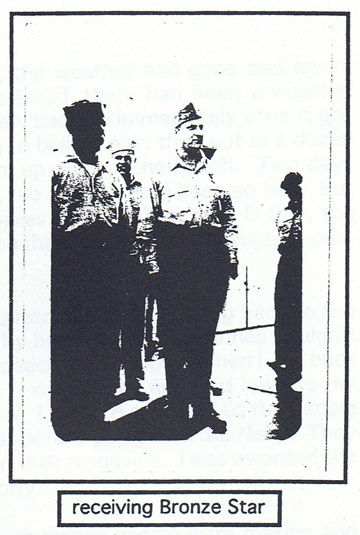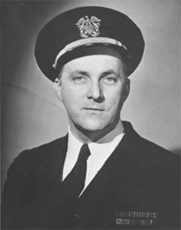
|
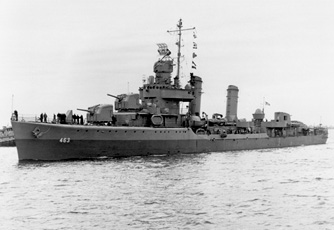
|
Paul N. Garay
Officer, USS Corry (DD-463)
(Excerpts)
(*Awarded the Bronze Star Medal for heroism in combat*)
In March of 1943, I was
transferred from the USS Charrette (DD-581) to the USS
Corry (DD-463). I was
the assistant engineer and damage control officer.
The USS Corry spent a lot
of time in the Caribbean, we also spent a lot of time up in the far north,
chasing German ships.
(Spring 1944) Then came the invasion and we were sent to England. We were waiting there for several weeks while the invasion fleet was getting underway. We knew eventually we'd go over and invade, but we didn't know when. The British were still getting bombed nightly, it seemed like the war might go on for a long time.
We guarded the merchant ships coming into England. We traveled a bit around Scapa Flow, Scotland, doing exercises with submarines. Then we got the word that we would be going over to Normandy. We started out for the 5th of June. We traveled all night across the Channel. The water was rough; there were lots of big barges loaded with tanks and trucks and supplies. If we went too fast the barges would get overwhelmed with water, so we could only go three or four miles an hour.
In the morning we were off the Normandy coast. The destroyers went in within a couple of miles of the beach, shooting at German gun emplacements. There were some bigger ships there also, a couple battleships and cruisers. Of course they weren't all American, some of them were British. The Germans had very strong emplacements set up, with concrete walls all around, so they were hard to damage.
The destroyer guns could shoot maybe five or six miles. We were taking some fire from the shore batteries. The firing was strong enough that the Allied Forces sent some airplanes to go out in front of the ships, to drop a smoke screen. It looked just like a regular curtain, but it was all smoke. The only trouble was, they didn't go to where the Corry was. The smoke went behind her. We were sitting out in front, fully exposed. One of the planes that had been spreading the smoke went into the water. Another was blown out of the air.
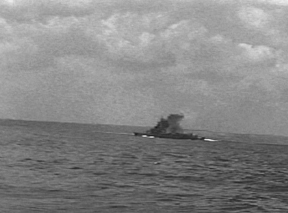
USS CORRY HIT
We ran into a mine. Destroyers are not very strong ships, they're fairly light. When we ran into this mine it broke the back of the ship. The water wasn't very deep there. The ship, of course, was sinking.
I was on damage control. A couple of the sailors brought what is called a handybilly, a little gasoline powered pump. They dropped the suction pipe down into the crack in the ship and started trying to pump it out. But as fast as they were pumping the water out, it was coming in through the rest of the crack.
The destroyers had two whaleboats, one on each side. Our men put one of the boats in the water, but they forgot to put the plug in it, so it started taking on water. They had to pull it up and put the plug in. All the time the ship was sinking and the Germans were shooting at us. We were told to abandon ship.
We dropped a life raft over the side facing the beach; eight or ten guys went down a net and got into it. My friend Benny Bensman, one of the gunnery officers, was one of them. I was up on the bridge and, just about that time, I saw a shell come over and land right where the life raft was. There was a big gush of water and when I looked again there was nothing there but some wreckage. We lost a lot of people overall.
Down underneath the wardroom were the magazines. I went down to the magazine deck and stomped on the floor a couple times. There were four or five people down there. I told them to come on out, that they weren't needed down there anymore. They undogged the hatch, lifted up the lid and got out just in time. Water was pouring in. Most of the people were already in the water by then.
As the ship was going down, with water coming up over the main deck, there was a lot to take care of. Several of us were standing by. The captain was right next to me. He was getting ready to go over the side. I looked at him and said, "Captain, you'd better take your shoes off, you'll be able to swim better." So he did. (Many years later he gave me a written piece of paper—it was a joke—saying I still owed him for a pair of shoes.) I happened to come through the wardroom and found the old steaming flag, the work flag. I grabbed it before I went overboard, our survivor's group still has it. A new flag had been put up; later on we could never figure out who had put up the new flag, but he was a brave man.
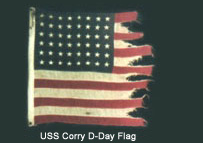
USS CORRY D-DAY FLAG
The ship went down, all that was sticking out was the top of the mast. We were all scattered around on floats and whaleboats. We were pretty concerned about the depth charges on the stern; if they went underwater they were liable to go off, which could've killed everyone. There was a group of men who were specifically assigned to deactivate the dept charges if the ship sank, and fortunately they had done their job, so that didn't happen. We had a good crew!
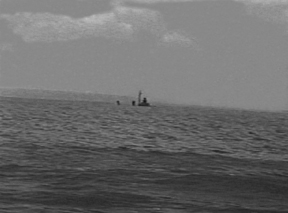
USS CORRY WRECKAGE
Shells were landing all around us. I managed to pull a couple of people out of the water. We were on a spar, some kind of an old raft or something. We all had life preservers on, but one guy had swallowed a lot of water. I tied him to the raft and we floated around there for about two and a half hours. We weren't' sure we'd get picked up. Finally, one of the other destroyers came around and got us.
When they picked up my friend Ed Biddle he was shaking so hard, he couldn't stop. We put him on board the pickup ship; the doctor had to give him a shot to sedate him, so he could stop shaking. They put some of the fellow in bunks, they were so cold. I didn't have as much trouble as most people, though. Maybe because I was fatter. (I guess!)
There were ships all over, all shooting. Smaller boats were going around picking people up. While we were on the ship we could see the troops going ashore, but once we went into the water we couldn't see the land anymore.
Later that day we were taken back to England. A ship could make that trip in about two hours. They sent us to a hospital and checked us out.
They were asking for volunteers to ride the LSTs, the big landing ships. I made one trip on an LST to Utah Beach. It was the best of the five beaches because it was relatively flat. They could get tanks onto Utah Beach fairly easily. By the time I went back, things were a lot calmer, the weather was better. We unloaded the LST and came back to England.
Later I was on a ship, the Queen Elizabeth, coming back to the US. She was a fast ship traveling by herself, the submarines couldn't keep up with her. It was a big ship, loaded with people. When I got back to New York I had a month's leave. I went home and said hello to my mother and some other people I knew. I went to say hello to the people at Fleet Wings, where I'd worked just before going into the Navy. They wrote up my story and published it in their magazine. I was awarded the bronze star for my action aboard the Corry.
I kept hearing stories about how much money people were making and what a good life they were having. It made me so mad, I went down to Washington and told them I wanted to go back to sea. I didn't even use my 30 day leave. The next day I was in an airplane, on my way to San Francisco. That's where I was assigned to the USS Dashiell (DD-659), another destroyer.
Paul N. Garay
Officer
USS Corry (DD-463)
BRONZE
STAR AWARD CITATION FOR PAUL GARAY:
|
